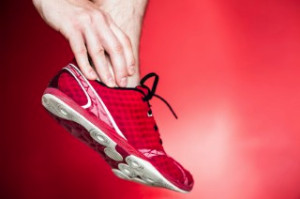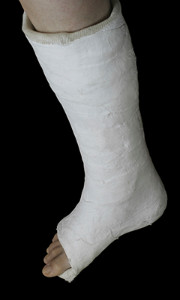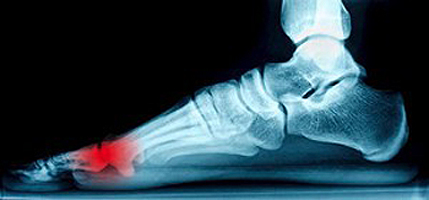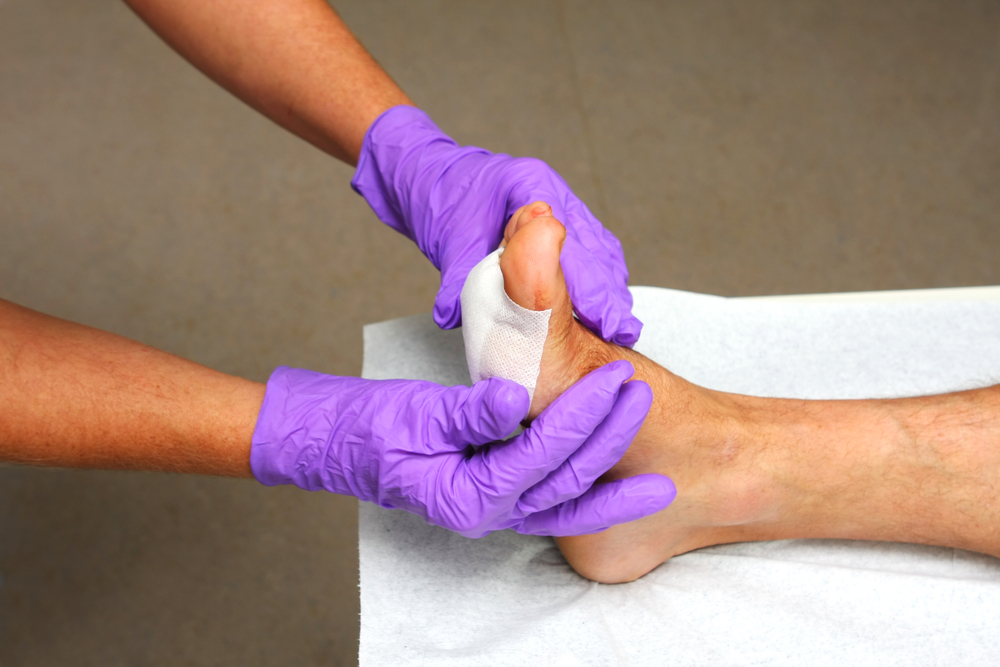 Research has shown the importance of wearing the correct running shoes that are appropriate for your style of running. Once the proper shoe size is determined, it may be beneficial to consider what type of running will be practiced. Trying shoes on later in the day when the feet are at their largest may help to ensure a proper fit. Additionally, the heel of the shoe should be solid, and this may help to provide stability to the feet and ankles. It may be beneficial to alternate between two pair of shoes, in addition to considering purchasing new shoes approximately five hundred miles. If you would like additional information about how to choose running shoes that are correct for you, please consult with a podiatrist who can properly guide you.
Research has shown the importance of wearing the correct running shoes that are appropriate for your style of running. Once the proper shoe size is determined, it may be beneficial to consider what type of running will be practiced. Trying shoes on later in the day when the feet are at their largest may help to ensure a proper fit. Additionally, the heel of the shoe should be solid, and this may help to provide stability to the feet and ankles. It may be beneficial to alternate between two pair of shoes, in addition to considering purchasing new shoes approximately five hundred miles. If you would like additional information about how to choose running shoes that are correct for you, please consult with a podiatrist who can properly guide you.
If you are a runner, wearing the right running shoe is essential. For more information, contact Dr. Richard DiMario from Maine. Our doctor can provide the care you need to keep you pain-free and on your feet.
Choosing the Right Running Shoe for Your Foot Type
To increase performance and avoid the risk of injury, it is important to choose the right running shoe based on your foot type. The general design of running shoes revolves around pronation, which is how the ankle rolls from outside to inside when the foot strikes the ground.
If you have any questions please feel free to contact our office located in York, ME . We offer the newest diagnostic and treatment technologies for all your foot and ankle needs.
 Most people have dealt with a stubbed toe, which can cause an immediate sharp pain. In most cases, this initial pain fades quickly. If the pain persists, however, this could be a sign of something serious. The pain associated with hitting your toe feels intense because there are many nerve receptors in your toes that are impacted by blunt force. If the toe is hit too hard, then this may cause a break or fracture, which will require medical attention. If you are unable to put weight on the toe or if walking causes discomfort, this could be a sign that your toe is broken. If you think you may have broken your toe or injured it severely, then it is highly recommended you speak with a podiatrist in order to learn about treatment options.
Most people have dealt with a stubbed toe, which can cause an immediate sharp pain. In most cases, this initial pain fades quickly. If the pain persists, however, this could be a sign of something serious. The pain associated with hitting your toe feels intense because there are many nerve receptors in your toes that are impacted by blunt force. If the toe is hit too hard, then this may cause a break or fracture, which will require medical attention. If you are unable to put weight on the toe or if walking causes discomfort, this could be a sign that your toe is broken. If you think you may have broken your toe or injured it severely, then it is highly recommended you speak with a podiatrist in order to learn about treatment options.
Broken toes may cause a lot of pain and should be treated as soon as possible. If you have any concerns about your feet, contact Dr. Richard DiMario from Maine. Our doctor will treat your foot and ankle needs.
What Is a Broken Toe?
A broken toe occurs when one or more of the toe bones of the foot are broken after an injury. Injuries such as stubbing your toe or dropping a heavy object on it may cause a toe fracture.
Symptoms of a Broken Toe
Although the injured toe should be monitored daily, it is especially important to have a podiatrist look at your toe if you have severe symptoms. Some of these symptoms include worsening or new pain that is not relieved with medication, sores, redness, or open wounds near the toe.
If you have any questions, please feel free to contact our office located in York, ME . We offer the newest diagnostic and treatment technologies for all your foot care needs.
 Stress fractures occur when the foot experiences continual micro-trauma. This is common in athletes who push themselves in order to improve their performance. Stress fractures are caused by accumulative micro damage and can lead to small or large breaks. The body is capable of healing micro damage before it accumulates, but if the overuse is too intense, then the foot does not have time to heal itself. Factors that increase the risk of stress fractures are high running mileage, training errors, low bone density, inappropriate footwear, and high ridged arches. The pain associated with stress fractures is usually gradual, but can also begin with sudden pain. Localized bony pain and tenderness are the most common signs of stress reactions or fractures. It is important to lower the level of impact on your foot if you start to experience symptoms, so your body can heal itself. If you think you may have a stress fracture or are showing early signs of one, then it is suggested you consult with a podiatrist to learn about treatment options.
Stress fractures occur when the foot experiences continual micro-trauma. This is common in athletes who push themselves in order to improve their performance. Stress fractures are caused by accumulative micro damage and can lead to small or large breaks. The body is capable of healing micro damage before it accumulates, but if the overuse is too intense, then the foot does not have time to heal itself. Factors that increase the risk of stress fractures are high running mileage, training errors, low bone density, inappropriate footwear, and high ridged arches. The pain associated with stress fractures is usually gradual, but can also begin with sudden pain. Localized bony pain and tenderness are the most common signs of stress reactions or fractures. It is important to lower the level of impact on your foot if you start to experience symptoms, so your body can heal itself. If you think you may have a stress fracture or are showing early signs of one, then it is suggested you consult with a podiatrist to learn about treatment options.
Activities where too much pressure is put on the feet can cause stress fractures. To learn more, contact Dr. Richard DiMario from Maine. Our doctor can provide the care you need to keep your pain free and on your feet.
Dealing with Stress Fractures of the Foot and Ankle
Stress fractures occur in the foot and ankle when muscles in these areas weaken from too much or too little use. The feet and ankles then lose support when walking or running from the impact of the ground. Since there is no protection, the bones receive the full impact of each step. Stress on the feet can cause cracks to form in the bones, thus creating stress fractures.
What Are Stress Fractures?
Stress fractures occur frequently in individuals whose daily activities cause great impact on the feet and ankles. Stress factors are most common among:
Symptoms
Pain from the fractures occur in the area of the fractures and can be constant or intermittent. It will often cause sharp or dull pain with swelling and tenderness. Engaging in any kind of activity which involves high impact will aggravate pain.
If you have any questions please feel free to contact our office located in York, ME . We offer the newest diagnostic and treatment technologies for all your foot and ankle needs.
 If you have broken a foot, you are aware of the severe pain that typically accompanies this condition. It may happen as a result of falling, or from enduring a sports injury. There are two different types of fractures, which are labeled as compound or closed fractures. The former represents a break in which the bone protrudes through the skin. Some of the symptoms that are associated with a broken foot may include pain in and around the affected area, in addition to possible bruising or swelling. Walking or standing may be painful, and many patients use crutches to increase mobility. After a proper diagnosis is performed, which typically includes having an X-ray taken, correct treatment can begin. This will generally consist of wearing a cast, protective boot, or splint. If you have broken your foot, please consult with a podiatrist who can prescribe the best course of treatment for you.
If you have broken a foot, you are aware of the severe pain that typically accompanies this condition. It may happen as a result of falling, or from enduring a sports injury. There are two different types of fractures, which are labeled as compound or closed fractures. The former represents a break in which the bone protrudes through the skin. Some of the symptoms that are associated with a broken foot may include pain in and around the affected area, in addition to possible bruising or swelling. Walking or standing may be painful, and many patients use crutches to increase mobility. After a proper diagnosis is performed, which typically includes having an X-ray taken, correct treatment can begin. This will generally consist of wearing a cast, protective boot, or splint. If you have broken your foot, please consult with a podiatrist who can prescribe the best course of treatment for you.
A broken foot requires immediate medical attention and treatment. If you need your feet checked, contact Dr. Richard DiMario from Maine. Our doctor can provide the care you need to keep you pain-free and on your feet.
Broken Foot Causes, Symptoms, and Treatment
A broken foot is caused by one of the bones in the foot typically breaking when bended, crushed, or stretched beyond its natural capabilities. Usually the location of the fracture indicates how the break occurred, whether it was through an object, fall, or any other type of injury.
Common Symptoms of Broken Feet:
Those that suspect they have a broken foot shoot seek urgent medical attention where a medical professional could diagnose the severity.
Treatment for broken bones varies depending on the cause, severity and location. Some will require the use of splints, casts or crutches while others could even involve surgery to repair the broken bones. Personal care includes the use of ice and keeping the foot stabilized and elevated.
If you have any questions please feel free to contact our office located in York, ME . We offer the newest diagnostic and treatment technologies for all your foot and ankle needs.
 When the feet are properly stretched, running and jumping activities may be easier and safer to perform. Painful injuries may be avoided if correct foot and ankle stretches are frequently practiced, and the overall health of the body may be positively affected. An effective foot stretch that is known as toe curling is effectively done by raising one foot and curling the toes, then repeating on the other foot. Some people find it beneficial to stretch one toe at a time, and this is referred to as toe yoga. Lifting and lowering the heels will help to strengthen the Achilles tendon, in addition to making the joints in the ankle stronger. If you would like more information on how to perform foot stretches, it is suggested to consult with a podiatrist who can properly assist you.
When the feet are properly stretched, running and jumping activities may be easier and safer to perform. Painful injuries may be avoided if correct foot and ankle stretches are frequently practiced, and the overall health of the body may be positively affected. An effective foot stretch that is known as toe curling is effectively done by raising one foot and curling the toes, then repeating on the other foot. Some people find it beneficial to stretch one toe at a time, and this is referred to as toe yoga. Lifting and lowering the heels will help to strengthen the Achilles tendon, in addition to making the joints in the ankle stronger. If you would like more information on how to perform foot stretches, it is suggested to consult with a podiatrist who can properly assist you.
Stretching the feet is a great way to prevent injuries. If you have any concerns with your feet consult with Dr. Richard DiMario from Maine. Our doctor will assess your condition and provide you with quality foot and ankle treatment.
Stretching the Feet
Stretching the muscles in the foot is an important part in any physical activity. Feet that are tight can lead to less flexibility and make you more prone to injury. One of the most common forms of foot pain, plantar fasciitis, can be stretched out to help ease the pain. Stretching can not only ease pain from plantar fasciitis but also prevent it as well. However, it is important to see a podiatrist first if stretching is right for you. Podiatrists can also recommend other ways to stretch your feet. Once you know whether stretching is right for you, here are some excellent stretches you can do.
It is best to go easy when first stretching your foot and work your way up. If your foot starts hurting, stop exercising and ice and rest the foot. It is advised to then see a podiatrist for help.
If you have any questions, please feel free to contact our office located in York, ME . We offer the newest diagnostic and treatment technologies for all your foot care needs.
 Sesamoiditis mostly affects young adults who engage in physical activities like running or dancing. It is a condition that affects the forefoot and the most common symptom is discomfort or pain under the big toe joint. Sesamoid bones are tiny bones within tendons that connect to the big toe, and sesamoiditis is a result of them being irritated. The tendons around the bones will also become inflamed, having similar effects to conditions like tendinitis. The onset of sesamoiditis is gradual, the pain usually begins as a minor ache, but after continuous activity the sesamoids become more aggravated. The mild ache will eventually turn into a throbbing pain that will be hard to ignore. In most cases of sesamoiditis, resting the foot will help alleviate painful symptoms. If you give your foot a break from physical activity and the pain persists, then it is highly recommended you make an appointment with a podiatrist to learn about treatment options.
Sesamoiditis mostly affects young adults who engage in physical activities like running or dancing. It is a condition that affects the forefoot and the most common symptom is discomfort or pain under the big toe joint. Sesamoid bones are tiny bones within tendons that connect to the big toe, and sesamoiditis is a result of them being irritated. The tendons around the bones will also become inflamed, having similar effects to conditions like tendinitis. The onset of sesamoiditis is gradual, the pain usually begins as a minor ache, but after continuous activity the sesamoids become more aggravated. The mild ache will eventually turn into a throbbing pain that will be hard to ignore. In most cases of sesamoiditis, resting the foot will help alleviate painful symptoms. If you give your foot a break from physical activity and the pain persists, then it is highly recommended you make an appointment with a podiatrist to learn about treatment options.
Sesamoiditis is an unpleasant foot condition characterized by pain in the balls of the feet. If you think you’re struggling with sesamoiditis, contact Dr. Richard DiMario of Maine. Our doctor will treat your condition thoroughly and effectively.
Sesamoiditis
Sesamoiditis is a condition of the foot that affects the ball of the foot. It is more common in younger people than it is in older people. It can also occur with people who have begun a new exercise program, since their bodies are adjusting to the new physical regimen. Pain may also be caused by the inflammation of tendons surrounding the bones. It is important to seek treatment in its early stages because if you ignore the pain, this condition can lead to more serious problems such as severe irritation and bone fractures.
Causes of Sesamoiditis
Treatment for sesamoiditis is non-invasive and simple. Doctors may recommend a strict rest period where the patient forgoes most physical activity. This will help give the patient time to heal their feet through limited activity. For serious cases, it is best to speak with your doctor to determine a treatment option that will help your specific needs.
If you have any questions please feel free to contact our office located in York, ME . We offer the newest diagnostic and treatment technologies for all your foot and ankle needs.
 A typical symptom that many pregnant women may notice is swollen feet. This may generally occur during the second and third trimester, and can be uncomfortable. This may be a result of a thickened blood flow, in addition to the growing fetus, uterus, and placenta. There may be several reasons why discomfort may be experienced, including standing or sitting for extended periods of time, exposure to heat during the summer months, improper sodium intake, or carrying more than one baby. Moderate relief may be found by elevating the feet frequently during the day, limiting caffeine and sodium intake, wearing comfortable shoes, and drinking plenty of fresh water daily. If the feet should suddenly appear swollen, it may be indicative of medical conditions that may be present. If you feel any pain in your feet, it is suggested to speak to a podiatrist who can properly determine the cause.
A typical symptom that many pregnant women may notice is swollen feet. This may generally occur during the second and third trimester, and can be uncomfortable. This may be a result of a thickened blood flow, in addition to the growing fetus, uterus, and placenta. There may be several reasons why discomfort may be experienced, including standing or sitting for extended periods of time, exposure to heat during the summer months, improper sodium intake, or carrying more than one baby. Moderate relief may be found by elevating the feet frequently during the day, limiting caffeine and sodium intake, wearing comfortable shoes, and drinking plenty of fresh water daily. If the feet should suddenly appear swollen, it may be indicative of medical conditions that may be present. If you feel any pain in your feet, it is suggested to speak to a podiatrist who can properly determine the cause.
Pregnant women with swollen feet can be treated with a variety of different methods that are readily available. For more information about other cures for swollen feet during pregnancy, consult with Dr. Richard DiMario from Maine. Our doctor will attend to all of your foot and ankle needs.
What Foot Problems Can Arise During Pregnancy?
One problem that can occur is overpronation, which occurs when the arch of the foot flattens and tends to roll inward. This can cause pain and discomfort in your heels while you’re walking or even just standing up, trying to support your baby.
Another problem is edema, or swelling in the extremities. This often affects the feet during pregnancy but tends to occur in the later stages.
How Can I Keep My Feet Healthy During Pregnancy?
If you have any questions please feel free to contact our office located in York, ME . We offer the newest diagnostic and treatment technologies for all your foot and ankle needs.
 Wounds take time and attention to heal, especially when they are on the foot. Similar to injuries known as bedsores, wounds on the bottom of the feet are constantly under pressure. This pressure slows the healing process, because blood flow is weakened. Keeping pressure off the wound is essential in order to get the blood flowing back into the foot and facilitate the healing process. This can be done in easy ways, such as sitting or laying down. Standing directly on a wound probably causes some discomfort anyway, so giving it time to breathe is important. If you have an open wound on your foot and have additional questions, then it is recommended that you speak with a podiatrist to learn about the proper treatment options.
Wounds take time and attention to heal, especially when they are on the foot. Similar to injuries known as bedsores, wounds on the bottom of the feet are constantly under pressure. This pressure slows the healing process, because blood flow is weakened. Keeping pressure off the wound is essential in order to get the blood flowing back into the foot and facilitate the healing process. This can be done in easy ways, such as sitting or laying down. Standing directly on a wound probably causes some discomfort anyway, so giving it time to breathe is important. If you have an open wound on your foot and have additional questions, then it is recommended that you speak with a podiatrist to learn about the proper treatment options.
Wound care is an important part in dealing with diabetes. If you have diabetes and a foot wound or would like more information about wound care for diabetics, consult with Dr. Richard DiMario from Maine. Our doctor will assess your condition and provide you with quality foot and ankle treatment.
What Is Wound Care?
Wound care is the practice of taking proper care of a wound. This can range from the smallest to the largest of wounds. While everyone can benefit from proper wound care, it is much more important for diabetics. Diabetics often suffer from poor blood circulation which causes wounds to heal much slower than they would in a non-diabetic.
What Is the Importance of Wound Care?
While it may not seem apparent with small ulcers on the foot, for diabetics, any size ulcer can become infected. Diabetics often also suffer from neuropathy, or nerve loss. This means they might not even feel when they have an ulcer on their foot. If the wound becomes severely infected, amputation may be necessary. Therefore, it is of the upmost importance to properly care for any and all foot wounds.
How to Care for Wounds
The best way to care for foot wounds is to prevent them. For diabetics, this means daily inspections of the feet for any signs of abnormalities or ulcers. It is also recommended to see a podiatrist several times a year for a foot inspection. If you do have an ulcer, run the wound under water to clear dirt from the wound; then apply antibiotic ointment to the wound and cover with a bandage. Bandages should be changed daily and keeping pressure off the wound is smart. It is advised to see a podiatrist, who can keep an eye on it.
If you have any questions, please feel free to contact our office located in York, ME . We offer the newest diagnostic and treatment technologies for all your foot care needs.